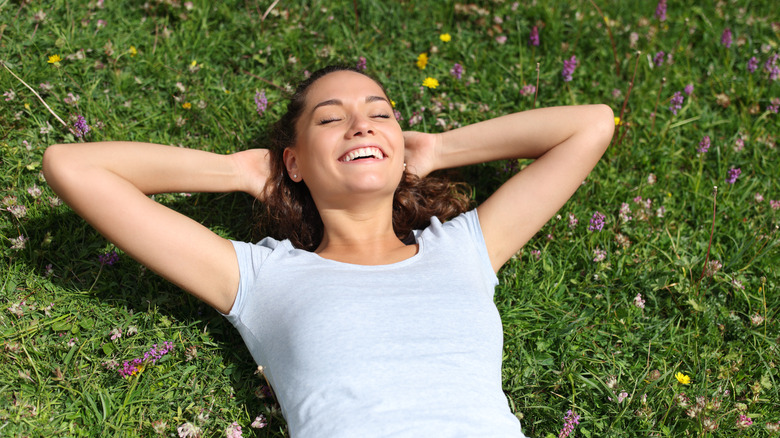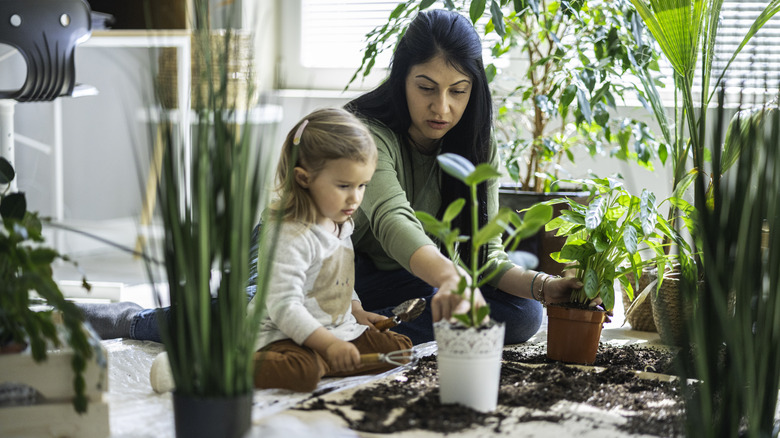How To Use Grounding To Improve Your Mental & Physical Health
One of the benefits of destigmatizing health issues is that more people feel encouraged to open up about their struggles and embrace their emotional vulnerability. It also inspires people to share the practices and coping mechanisms they've found helpful. An example of this is grounding or earthing, a therapeutic technique where one reconnects with the earth by being in direct skin contact with it. As author and spiritual teacher Deepak Chopra mentioned in the Huffington Post, these days, we don't typically find ourselves barefoot on the ground, which serves to connect us with the energy of the Earth. He further posited that the rise of autoimmune diseases and other illnesses could be related to how modern lifestyle has left us disconnected from this healing energy.
According to Healthline, while small studies have highlighted the positive impact of grounding, there's not enough research to definitively prove its benefits. However, that has not stopped wellness enthusiasts and even celebrities from recommending grounding, from Gwyneth Paltrow — or at least Goop — to Naomie Harris and Chelsea Handler. Some of its reported benefits, according to a 2022 study in Healthcare, are improved mood and quality of sleep due to its regulation of the body's circadian cortisol patterns, as well as reduced inflammation, chronic pain, and fatigue. A 2018 study in Alternative Therapies In Health And Medicine also discovered that it can be a form of therapy for lowering hypertension, though further research is needed to yield more conclusive findings.
Why getting grounded is good for you
Though it has a similar name, this type of grounding is different from the technique used and taught in mental health treatment. Whereas the latter helps one disengage from anxiety-inducing thoughts, like the Sunday scaries, by focusing on the senses and being more present, the former brings the body to a state of stasis by working on its living matrix that connects all of its cells, per Healthline. This network conducts electricity from the earth to boost the immune system and relieve the cells, tissues, and organs of oxidant stress.
On the other hand, being ungrounded causes disruption to the body's electric systems. According to a 2015 study in the Open Access Journal of Sports Medicine, staying mostly indoors exposes us to the electromagnetic fields produced by appliances, wiring, and lights, which makes us vulnerable to free radicals and alternating current voltages of 3.50 V or higher. "Because the body is a semiconductor in an aqueous solution, unnatural charges could interfere with the normal function of human processes," the study stated. Getting grounded reduces the body's electrostatic charge closer to Earth's electric potential of 0 V and infuses it with more negative electrons that can fight off free radicals.
It is important to note that most studies on grounding's benefits are small (usually with less than 100 adults as subjects) and base their findings on the participants' subjective perceptions of improvement post-treatment, which were generally self-administered.
Go outside and touch grass - literally
Grounding's popularity has been rising in recent years as people look for healthier ways to cope with fatigue and inflammation and to get better sleep. While it remains an under-researched subject, its potential as a simple, all-natural measure for addressing various health concerns makes it attractive to people invested in their wellness. In fact, Glamour declared grounding as one of this year's wellness trends.
To experience its benefits, Mindvalley recommends doing it for 30 minutes daily. If you are lucky to live or work where there's a green space nearby, make the most out of it. That clapback that is typically used against terminally online people? It turns out, there's some wisdom behind it. Go outside and touch some grass. Take barefoot walks on it. Lie down on it, too, if there is enough space. Just make sure to apply sunscreen before heading out and clear the ground of any sharp objects, fecal matter, and rubbish you might step in or lie on.
When on a trip, take advantage of possible access to natural bodies of water since swimming in the ocean or a lake is a form of grounding too. Reclining in the beach's sandy shoreline or bathing in a mud pit is also a good alternative. No matter your available grounding method, pay attention to how the earth or the water feels against your skin. Relax, take deep breaths, and immerse yourself in the feeling of being more connected to nature.
How to get grounded indoors
Urban dwellers with no access to nature trails, gardens, lawns, or parks can still practice grounding indoors by using various grounding equipment such as mats, blankets, socks, and patches. These replicate the Earth's electric currents, allowing you to enjoy the sense of realignment being grounded brings. Lie on a grounding mat while meditating or roll it out under your desk so you can place your bare feet on it while working. You can also wear grounding socks and patches as you sleep.
Another appealing indoor grounding practice you can get into is tending to a domestic garden. Depending on the available space, you can set it up on your rooftop or on a windowsill where you can then cultivate your choice of plants. The point is to handle the dirt with your bare hands to harness its electric energy. An extra perk is the pleasure you take from the homey charm a small garden lends to your space.
Grounding isn't an all-encompassing solution
While there's plenty of reported good in reconnecting with nature via grounding, experts caution against using it as the sole method for treating health conditions. For chronic medical issues such as inflammation and fatigue, one must still address their root causes under the guidance of a doctor. The same applies to mental health problems such as anxiety, insomnia, and depression: It wouldn't hurt to use grounding as a supporting treatment, but it shouldn't be relied on as the main one.
Grounding enthusiasts also warn against possible negative side effects. Because of the electrical energy flowing into the body, Mindful Zen advised observing for signs of detoxification afterward: headaches, rashes, and flu-like symptoms. Grounding newbies may also feel increased anxiety because of the novel sensation, especially when using at-home grounding equipment in high-voltage environments where there's an increased risk of shock. As for outdoor grounding, hazards come in the form of allergenic plants that cause skin irritation and pathogens in the soil that could enter the body through wounds, cuts, and scratches.
To avoid these risks, Verywell Mind recommended finding a grounding expert or joining a grounding community so people knowledgeable about the practice can guide you through your first session. They can also suggest reliable equipment you can use at home. Since grounding's benefits don't happen overnight, you must practice it consistently to see positive changes. A support group can help you develop and follow a routine you can adapt to with ease.
Using nature to heal
Although more research is needed to conclusively substantiate the benefits of grounding, it's hard to refute the positive effects of spending time in nature. For one, it gets us to step away from our gadgets. Getting some sunlight and fresh air refreshes our minds and re-energizes our bodies after we've spent hours sitting and working at our desks. Being in a natural environment also presents us respite from the mental and sensory over-stimulation caused by our highly digital lifestyle. It calms us down and gets us to be more in tune with our bodies.
Such is nature's restorative power that Japan even developed the ecotherapy practice shinrin-yoku or "forest bathing" to help its urban citizens cope with the collective stress and burnout caused by the 1980s tech boom. More recently, South Korea began creating a network of healing forests where people can recover from the pressures of their competitive work and academic environments. These are complemented by comprehensive forest healing programs that serve everyone, from expecting parents to patients with chronic diseases and even developmental disorders. By "medicalizing" nature, as National Geographic puts it, the country is improving its citizens' quality of life at lower medical costs.
Even when we don't have similar systemic support, we can be proactive in reconnecting with the environment, whether it's through grounding or simply soaking up the outdoors' sights, sounds, and sensations. Studies merely support what our bodies and minds already tell us: Being out in nature simply feels good.





